“Sea Horse, run!” is now the featured video on my YouTube Channel. Watch and listen as I read the story.
“Sea Horse, run!” is now the featured video on my YouTube Channel. Watch and listen as I read the story.
 “Sea Horse, run!” is the second place winner in the “Children – Early Reader (6 to 8)” category of the 2011 Reader Views Literary Awards. Winners were announced March 7, 2012, and all winners are given a gold “2012” logo to place on their website or on the cover of their book.
“Sea Horse, run!” is the second place winner in the “Children – Early Reader (6 to 8)” category of the 2011 Reader Views Literary Awards. Winners were announced March 7, 2012, and all winners are given a gold “2012” logo to place on their website or on the cover of their book.
Based in Austin, Texas, Reader Views has been granting awards to independent publishers since 2006. Reader Views began as a review service for independent publishers in December 2005, and since then their book reviews have been featured on television and in major newspapers throughout the United States. They offer awards in a variety of categories including regional, global, and specialized awards. Here is an excerpt of the eligibility and judging rules for the 2011 Award from the Reader Views Award entry page:
* * * * *
Eligibility
Reader Views Literary Awards are open to all authors regardless of residency, however, the books must be published in the English language and targeted for the North American market. Work published by major book publishers are not eligible. Books must have a 2011 copyright date. (Copyright date is on the copyright page of the printed book. Yes, that means copyright date – no, it doesn’t mean a copyright date of 2010 and publication in 2011. This means copyright in 2011.) Submission for more than one category or more than one title is acceptable. Books that have racist themes will be not be accepted.
Judging
All initial judging will be done by reviewers from Reader Views. They are experts in their fields as well as avid readers. Consider them your reading audience. Criteria for judging is content/originality, presentation/design, innovation, social relevance, production quality, enjoyment/impact, plot/story line, and resoursefulness (depending on category.) Three finalists in each category will be determined by a point system. Final judging will be determined by a jury of judges.
Each category has a First, Second and Honorable Mention placement. More than one mention in the category means there is a tie. If there are less than three in a category it means the remaining entries’ scores were below the cut-off point. Our judges are strict!
* * * * *
How do you know if an award dedicated to independent publishers is legitimate? Read this great article published on WRITER BEWARE in 2010: http://accrispin.blogspot.com/2010/12/some-tips-on-evaluating-literary.html
Reader Views is a legitimate, established service for independent publishers and writers. The Association of Independent Authors recognized Reader Views as one of the best websites for both book awards (see winners list) and reviews (see winners list). In January 2007 Preditors & Editors gave Reader Views its “Truly Useful Site Award.” This award is given to websites, designed for writers and publishers, that have proven not only useful or entertaining but also set a standard for other sites to aim for.
If you would like to enter your independently published book into the Reader Views book award contest, visit their award page where you can also subscribe to their newsletter. Thank you, Reader Views, for the award!
When creating “SEA HORSE, RUN!”, I visited seven different aquariums, but most of my sea dragon research was conducted at the Dallas World Aquarium. Their leafy sea dragon exhibit is the best I’ve ever seen! I often tell students in the Dallas Metro area that I researched my book in downtown Dallas at the DWA Zoo, so I was thrilled last week to learn that the Dallas World Aquarium featured my book in their Winter 2011 newsletter, Eco Currents.
Since “SEA HORSE, RUN!” was the “Book of the Month,” it was also featured in their gift shop.
Many thanks to the Dallas World Aquarium for highlighting my book.
A random google search produced an unexpected review for “SEA HORSE, RUN!” in December 2011. Rob Schupbach’s blog entitled, “Raven, Writing Desk, and Children’s Literature: A Children’s Literature Review Blog,” featured “SEA HORSE, RUN!” on December 18th. I love his description of the book:
“Although the book is quite informative, it is also entertaining. After hearing rumors about a dragon, the animals of the ocean were frightened and began to find safe havens. Not Sea Horse. He had the courage to stay behind and protect his friend, coral, who cannot move. Sea horse confronts the danger and faces his fears. He soon realizes that the sea dragon and the sea horse are distantly related. This underlying message of courage in the face of danger and standing by a friend can be very powerful to young students.”
http://robschupbach.blogspot.com/2011/12/sea-horse-run.html
Many thanks, Rob, for the great review!
I can’t wait to watch the BBC documentary entitled ‘Great Barrier Reef.’ The latest ‘moralcoral’ post is awesome! Be sure to check out her blog.
For those of you who have been lucky to catch ‘Great Barrier Reef’ on BBC2 over the New Year, you will have been rewarded with breath-taking scenery and an insight in to the underwater world in high definition. However for some, the great continent of Australasia may seem very far away. So why should we be interested in coral reefs and what’s in it for us as a nation to protect them? Well coral reefs are actually a lot closer to home than you may think. The world’s largest marine reserve, home to productive and pristine coral reefs, huge schools of fish, docile turtles and predatory sharks, actually lies within the British Indian Ocean Territory.
The Chagos Archipelago is a group of over 60 islands in the Indian Ocean and home to the world’s largest coral atoll. The marine reserve was officially established in 2010 and covers an area of…
View original post 435 more words
Mrs. Daniel’s 4th grade class at Nolan Elementary in Signal Mountain, Tennessee gave me a wonderful set of pictures based on my books. Here is a sample of their work from “Sea Horse, run!”.
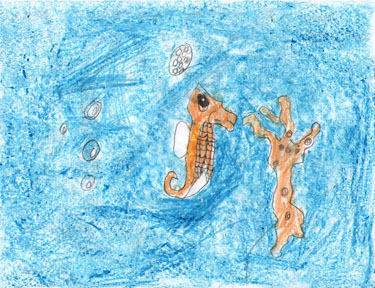
Keegan drew the above picture of Sea Horse. His question on the back of the picture reads: “How did sea horse hear coral, a plant, singing to him?”
Great question, Keegan! Coral is not a plant. Coral looks like a plant, but she is actually a group of tiny animals. A choir or chorus is an organized group of singers, and since Coral is an organized cluster of tiny animals, I thought she ought to sing like a choir.
Learn more about why Coral sings in the story by reading Coral as Greek Chorus or click on a question below to learn more about corals:
What is a coral polyp?
How do polyps eat?
How are corals named?
Why are corals important to sea horses?
Do coral polyps have eyes?
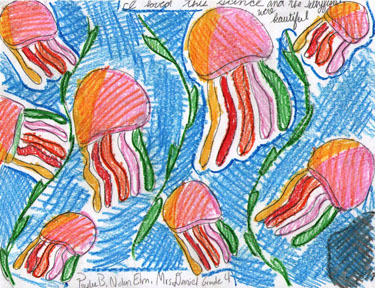
Preslee likes my jellyfish. I like Preslee’s jellies (above), too!
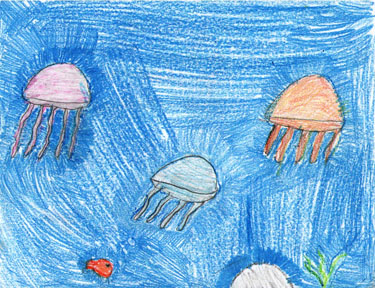
Nick also drew jellies (above). Nick asks, “Why did you pick jellyfish for the dedication page?”
Jellyfish are a symbol for acceptance, so the appearance of jellyfish before the story even begins foreshadows or predicts that acceptance will be an important theme in the story. The poor Sea Dragon is misunderstood! Sea Horse learns to ignore gossip and accept Sea Dragon for who he really is.
The sea horse has an amazing life cycle that begins with the courtship dance. Once the courtship is complete, the female fills the male’s brood pouch with eggs. Baby sea horses grow in the male’s brood pouch, and as you can see in my illustration above, the male sea horse gives birth. Depending on the species, one birth can produce about 1,500 babies. What a fascinating fish!
Sea Horse Courtship Dance at the Monterey Bay Aquarium:
[youtube http://youtu.be/zvGRVWGpdNg]More Blog Posts About Sea Horses:
This post answers basic questions such as…
Why are corals important to sea horses?
Draw Sea Horse with the Dot-to-Dot Activity.
Label and color the Sea Horse Diagram.
Recommended books and resources are on my Teacher/Student page.
Several people (both students and adults) have asked me why I chose to call my new book “Sea Horse, run!” instead of “Sea Horse, swim!”especially since the later seems more grammatically correct. I considered “Sea Horse, swim!” for my book title. I even changed all of the text accordingly, but in the end I chose “Sea Horse, run!” as the book’s catch-phase and title for one reason: poetic license. It sounds like a pitiful excuse, but poetic license is defined as “the freedom to depart from the facts of a matter or from the conventional rules of language when speaking or writing in order to create an effect.”
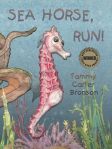 Consider that poetry and picture books have a lot in common.
Consider that poetry and picture books have a lot in common.
1) Both are generally short.
2) Both are usually read aloud.
3) Most importantly, word choice is paramount.
Let’s consider each in depth.
1) Picture books are generally under a thousand words, and new or early readers require many one syllable words. Both ‘run’ and ‘swim’ are one syllable, so the length of the words did not help me choose between them. But…
2) Poetry and picture books are usually read aloud. When I wrote the version entitled, “Sea Horse, swim!”, it was awkward to read, especially aloud. The words ‘sea’ and ‘swim’ slur together, and since the phrase is often repeated, I grew tired of stumbling over the words. I knew if I had a hard time reading it out loud then a child would have trouble, too.
3) So ‘run’ sounds better, but why? Word choice. It comes down to a battle of consonants: hard versus soft. Consonants create hard or soft sounds. Hard consonants stop the flow of air by blocking it with the tongue or lips, whereas soft consonants only partially block air flow. In “Sea Horse, swim!” both ‘sea and ‘swim’ begin with soft consonants. This is a problem because the sentence as a whole is a command and using a soft consonant for the verb is not very commanding. By contrast, the ‘r’ in ‘run’ is a hard consonant which stops the flow of air, a nice compliment to the soft ‘s’ in ‘sea’. Using a hard consonant for the verb ‘run’ also gives the statement a more authoritative ring.
Poetry uses words in new, unconventional, or even playful ways. That’s what makes poetry fun. Picture books do likewise. I play with words in “Sea Horse, run!”. For example, Coral is choral in my story, and using ‘run’ instead of ‘swim’ is just another playful use of words.
But before I considered poetic license, I researched the word ‘run’ with respect to fish. If you google ‘fish’ and ‘run’ you’ll find lots of associations and sentences using the two words. For example:
Why do fish run when hooked?
Why do fish run away when you tap the fish bowl?
When are the salmon running?
Water runs.
Rivers run.
Why not let Sea Horse run?
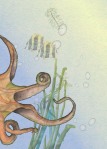 But I liked “Sea Horse, swim!”, too, so I kept it on one page. Octopus exclaims, “Sea Horse, swim!”, on page 13. Octopi are clever, so I thought his sentence structure should be beyond reproach.
But I liked “Sea Horse, swim!”, too, so I kept it on one page. Octopus exclaims, “Sea Horse, swim!”, on page 13. Octopi are clever, so I thought his sentence structure should be beyond reproach.
Finally ‘swim’ does not communicate a sense of urgency or direction, whereas ‘run’ does. But did you know that some fish can even walk?
http://en.wikipedia.org/wiki/Walking_fish
Will my next book be, “Catfish, walk!”? Probably not, but I will add that title to my ever-increasing list of potential books.
Big News for November 2011:
in the
Children’s Picture Book Hardcover Fiction Category.
Read the Press Release for the 2011 USA Best Book Awards
The winner in my category is by far one of my favorite books of the year:
Written by Devin Scillian and illustrated by Tim Bowers.
Congratulations Devin, Tim, and Sleeping Bear Press!
I bought a copy, and
I must say…
You made a spectacular book!
Wildlife Update : From the tropics to the Thames: Seahorses discovered in London.
London is one of my favorite cities, and when a sea horse was discovered in the River Thames earlier this month, I planned to write about it on my blog. Instead, I’m recommending this wonderful article posted on Henricus Peters’ LEARN FROM NATURE blog.